Environmental Engineering Reference
In-Depth Information
φ
'
Angle of internal friction [deg]
28
o
29
o
30
o
36
o
40
o
45
o
Very
Loose
Medium
Dense
Very
Dense
Loose
Dense
80
Sand above the
water table
60
40
20
Sand below the
water table
0
0 0
0
0
0 0
Relative density [%]
Figure 25 : Initial modulus of subgrade reaction
k
s
as a function of friction angle
φ
′
[ 6 ].
Due to its discontinuous nature soil particles can move with respect to the sur-
rounding particles, thereby altering the structure of the soil. This creates a sig-
nifi cantly non-linear behaviour which is usually described in terms of load
displacement diagrams.
For a single pile in soil the pile-soil interaction can be described in terms of
lateral resistance, shaft friction and end bearing. This behaviour is commonly
modelled as non-linear load displacement curves:
P
-
y
curves for the lateral resis-
tance and
t
-
z
and
Q
-
z
curves for the shaft friction and the end bearing respectively.
Figure 26 shows
t
-
z
curves for sand and clay [6].
To model the soil reaction loads a set of soil springs is used. Figure 27 shows
the springs for the horizontal and vertical direction as well as for the pile
plug [ 4 ].
5 Support structure design
5.1 Design steps
The design of the support structure is an iteration between tuning the dynamic
properties, optimising the amount of steel needed to resist all load cases and re-
calculating the loads on the optimised structure. Figure 28 shows the design steps
that are typically required to come to a complete design of a support structure.
The different design steps have a strong interdependence and several iteration
steps are normally required to come to an optimal design. For an entire offshore
wind farm, some design details can be fi xed. For instance, the hammer for installing













Search WWH ::

Custom Search